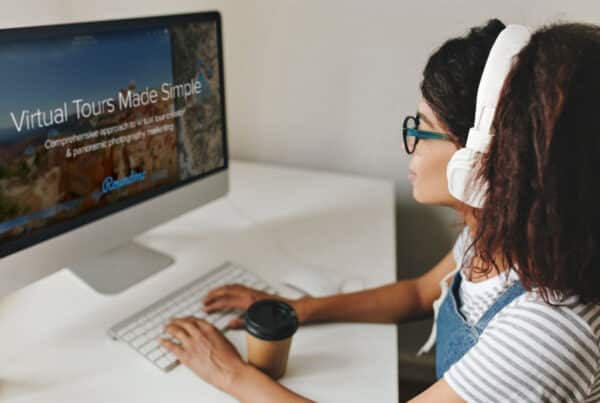
In the age of digital innovation, the way businesses market themselves is constantly evolving. One significant shift has been the rise of virtual tours as a powerful tool for showcasing products, services, and properties. But does this mean traditional tours are becoming obsolete? Let’s explore the strengths and weaknesses of both approaches to determine which might be better suited for your business, whether you’re a virtual tour provider or rely on traditional methods.
Virtual Tours: Embracing the Digital Revolution
Virtual tours leverage cutting-edge technology to provide immersive experiences to potential customers. With advancements in virtual reality (VR) and 360-degree photography, businesses can now offer interactive tours from the comfort of a computer or smartphone screen. Here’s why virtual tours might be the right choice for your business:
- Global Reach: One of the most significant advantages of virtual tours is their ability to reach a global audience. Unlike traditional tours that require physical presence, virtual tours can be accessed from anywhere with an internet connection. This opens up new markets and eliminates geographical barriers.
- Cost-Effective: Setting up a virtual tour can be more cost-effective than organizing traditional tours. There’s no need to arrange transportation, accommodation, or physical space for showcasing products or properties. This makes virtual tours an attractive option, especially for small businesses with limited resources.
- Enhanced Engagement: Virtual tours offer an immersive experience that engages potential customers on a deeper level. Through interactive features like clickable hotspots and multimedia content, businesses can provide detailed information and create memorable experiences that leave a lasting impression.
- Data Insights: Another advantage of virtual tours is the ability to gather valuable data and analytics. Businesses can track metrics such as engagement time, click-through rates, and popular viewing angles to gain insights into customer behavior. This data can inform marketing strategies and improve the overall customer experience.
However, virtual tours also have their limitations:
- Lack of Personal Interaction: While virtual tours offer immersive experiences, they may lack the personal touch of traditional tours. Face-to-face interactions can build rapport and trust with potential customers in ways that virtual experiences cannot replicate.
- Technical Barriers: Not all customers may have access to the necessary technology to engage with virtual tours effectively. Older demographics or those with limited internet connectivity may prefer traditional tours for their simplicity and accessibility.
- Limited Sensory Experience: Virtual tours primarily rely on visual and auditory stimuli, which may not fully capture the sensory experience of a physical tour. Factors like texture, scent, and ambiance are difficult to replicate virtually, potentially affecting the overall impression of the product or property.
Traditional Tours: Embracing Time-Tested Methods

Traditional tours have been a staple of business marketing for decades, offering a hands-on approach to showcasing products, services, and properties. Here’s why traditional tours might still have a place in your business strategy:
- Personalized Interaction: Traditional tours allow for face-to-face interactions between businesses and customers, fostering personal connections and building trust. The ability to address questions, provide demonstrations, and offer immediate feedback can enhance the customer experience and facilitate sales.
- Multi-Sensory Experience: Unlike virtual tours, traditional tours engage multiple senses, providing a more holistic experience for customers. Touching, feeling, and experiencing products or properties first hand can create a stronger emotional connection and drive purchasing decisions.
- Flexibility and Adaptability: Traditional tours offer flexibility in terms of customization and adaptation to specific customer needs. Businesses can tailor tours to highlight key features, address customer preferences, and showcase unique selling points in real-time.
- Established Trust: For certain industries, particularly high-value purchases or investments, traditional tours may instill a greater sense of trust and credibility. Seeing products or properties in person can alleviate concerns about quality, authenticity, and reliability.
However, traditional tours also have their drawbacks:
- Limited Reach: Unlike virtual tours, traditional tours are constrained by physical location and logistical challenges. This limits their reach to local or regional audiences and may exclude potential customers who are unable to attend in person.
- Higher Costs: Organizing traditional tours can be more expensive than virtual alternatives, requiring expenditures on travel, venue rental, staffing, and promotional materials. For businesses operating on a tight budget, this may pose a significant barrier.
- Time Constraints: Traditional tours require scheduling appointments and coordinating logistics, which can be time-consuming for both businesses and customers. Delays or cancellations may disrupt plans and inconvenience participants, potentially impacting the overall experience.
Finding the Right Balance
In conclusion, the choice between virtual tours and traditional tours depends on various factors, including your business goals, target audience, budget, and industry norms. While virtual tours offer scalability, cost-effectiveness, and data-driven insights, traditional tours excel in personal interaction, sensory experience, and established trust.
Ultimately, the most effective approach may involve a combination of both virtual and traditional methods, leveraging the strengths of each to create a comprehensive marketing strategy. By embracing technology while preserving the human touch, businesses can maximize their reach, engagement, and conversion potential in an increasingly competitive market landscape.
Discover the benefits of virtual tours over traditional ones for your business.
Engage more customers with immersive, interactive experiences that stand out. Contact us today to learn how our cutting-edge solutions can enhance your business. Reach out now to start transforming your tours and capturing your audience’s attention!




